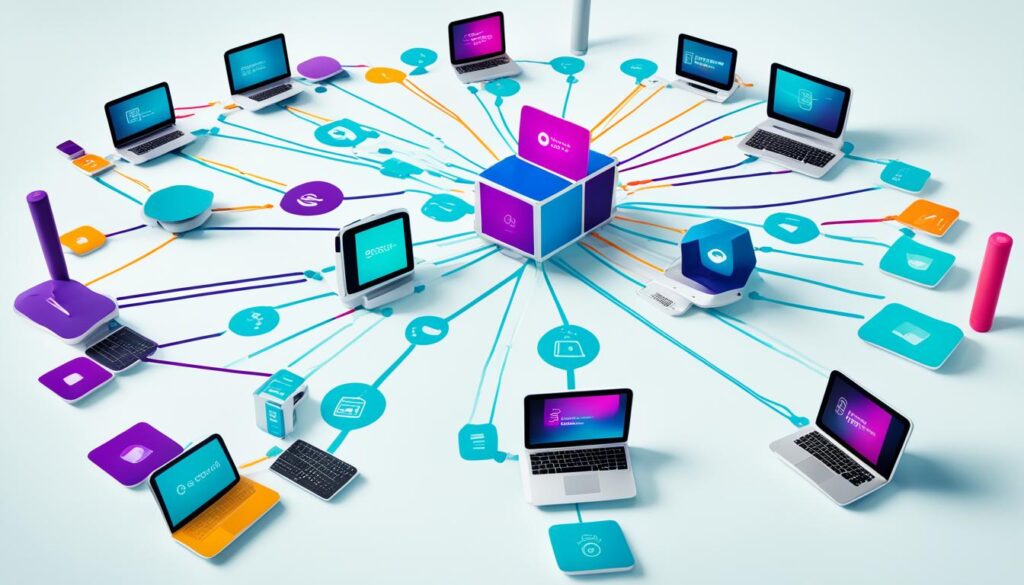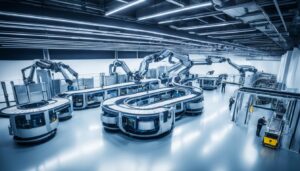
Data is increasingly seen as a key organizational asset, and organizations are looking for ways to use it more effectively. The challenges of managing large amounts of data and extracting meaningful insights from it require the right technologies. Understanding the available technologies and how they can be combined is crucial for leveraging data as a critical asset.
Key Takeaways:
- The right technologies are essential for managing and leveraging data effectively.
- Data plays a crucial role in organizational success and decision-making.
- Combining machine learning, artificial intelligence, IoT, penetration testing, speech and NLP, data visualization, and predictive analytics enhances data utilization.
- Effective data management requires ensuring data security through technologies like penetration testing and intelligence practice.
- Data visualization and predictive analytics technologies enable organizations to gain meaningful insights and make informed decisions.
Machine Learning and Artificial Intelligence (AI)
Machine learning and artificial intelligence (AI) are powerful technologies that have the potential to revolutionize the way organizations operate. By combining AI with machine learning, companies can automate tasks, improve efficiency, reduce costs, and make better-informed decisions. These technologies excel in managing and analyzing large and complex data sets, identifying trends and patterns that may be invisible to humans.
Machine learning algorithms can process vast amounts of data at incredible speeds, constantly learning and adapting to provide accurate insights. This enables organizations to unlock valuable information and gain a competitive advantage. AI-powered data analytics can simplify complex tasks, reducing the time and resources required for analysis. Through automation and intelligent algorithms, organizations can streamline processes, optimize workflows, and make data-driven decisions more effectively.
One of the key benefits of machine learning and AI is their ability to identify patterns and make predictions. By leveraging historical data and applying advanced algorithms, these technologies can forecast future trends and outcomes. This predictive capability empowers organizations to proactively plan, optimize resources, and stay ahead in a rapidly changing business landscape.
Machine learning and artificial intelligence are the driving forces behind data analysis and automation. They can uncover hidden patterns, automate complex tasks, and provide valuable insights to guide decision-making.
The combination of machine learning and AI has transformative potential across various industries. For example, in healthcare, these technologies can assist in disease diagnosis and treatment planning. In finance, AI-powered algorithms can optimize investment portfolios and detect fraudulent activities. In manufacturing, machine learning can improve production efficiency and reduce costs.
Overall, machine learning and artificial intelligence bring significant advantages in the realm of data analysis and automation. They enable organizations to harness the power of data, make informed decisions, and achieve operational excellence. Embracing these technologies is essential for organizations seeking to stay competitive in the digital age.
Benefits of Machine Learning and Artificial Intelligence (AI)
Here are some key benefits of incorporating machine learning and artificial intelligence into organizational processes:
- Automation: ML and AI can automate repetitive tasks, freeing up valuable human resources while increasing efficiency and productivity.
- Data analysis: These technologies excel in analyzing large and complex data sets, identifying patterns, and extracting meaningful insights.
- Improved decision-making: ML algorithms can suggest the most effective course of action based on data analysis, enhancing decision-making processes.
- Cost reduction: Automation and optimized processes driven by ML and AI can lead to significant cost savings for organizations.
Machine Learning and Artificial Intelligence (AI) in Action
To illustrate the practical applications of machine learning and AI, let’s take a look at a real-life example:
| Industry | Application |
|---|---|
| E-commerce | Personalized product recommendations based on customer behavior and preferences. |
| Transportation | Optimization of route planning and real-time traffic prediction for efficient logistics. |
| Healthcare | Early detection of diseases through the analysis of medical images and patient data. |
By leveraging machine learning and artificial intelligence, organizations in various industries can enhance their operations, deliver personalized experiences, and drive innovation.
Internet of Things (IoT) and Electronic Devices
The Internet of Things (IoT) and electronic devices play a critical role in data collection and connectivity. IoT devices gather real-time data, enabling organizations to make informed decisions. The vast amount of data generated by these devices can contribute to the overall understanding of customers, improve operational efficiency, and provide valuable insights.

The integration of IoT and electronic devices with other technologies enhances the management and utilization of data. Through seamless connectivity, these devices enable the collection of valuable data, allowing organizations to gain a comprehensive understanding of various aspects of their operations.
“The Internet of Things will connect and automate a wide range of electronic devices, revolutionizing how we interact with data and make decisions.” – Mark Johnson, IoT expert.
By leveraging the capabilities of IoT and electronic devices, organizations can optimize processes, improve efficiency, and create innovative services. These technologies enable continuous data collection, which allows businesses to monitor and analyze performance in real-time, leading to quick and data-driven decision-making.
Enhancing Data Collection and Connectivity
The connectivity provided by IoT facilitates seamless data exchange between devices and systems, enabling real-time data collection, transmission, and analysis. This interconnected network of devices creates a wealth of information that can be used to gain valuable insights, identify patterns, and make predictive analyses.
IoT devices, such as sensors and smart devices, collect data on various parameters, such as temperature, pressure, location, and usage. This data can be utilized to optimize operations, detect anomalies, and identify opportunities for improvement.
Improving Operational Efficiency
The integration of IoT and electronic devices with other technologies leads to improved operational efficiency by automating processes and streamlining workflows. For example, IoT-connected devices in manufacturing can automatically monitor equipment status, trigger maintenance requests, and optimize production schedules, reducing downtime and maximizing productivity.
Moreover, the data collected by IoT devices can be used to detect and address issues proactively, preventing potential disruptions and reducing maintenance costs. By analyzing real-time data, organizations can implement predictive maintenance strategies, ensuring optimal performance and minimizing costly unplanned downtime.
Creating Valuable Insights
The extensive data collected by IoT devices provides organizations with valuable insights into customer behavior, preferences, and usage patterns. This information can be used to personalize customer experiences, tailor marketing campaigns, and develop new products and services that meet customers’ evolving needs.
Furthermore, the integration of IoT with analytics and artificial intelligence enables organizations to derive actionable insights from complex data sets. By leveraging advanced analytics techniques, organizations can uncover hidden patterns and correlations, enabling better strategic decision-making and competitive advantage.
Penetration Testing and Intelligence Practice
When it comes to data security, organizations cannot afford to take any chances. The rise in cyber threats and data breaches highlights the need for robust security measures that can effectively protect sensitive information. This is where penetration testing and intelligence practice come into play. These essential technologies play a crucial role in identifying vulnerabilities, mitigating risks, and ensuring data integrity and confidentiality.
Penetration testing involves simulating real-world cyber attacks to uncover weaknesses in an organization’s systems and networks. By deliberately attempting to exploit vulnerabilities, security experts can assess the effectiveness of existing security measures and identify areas of improvement. The insights gained from penetration testing allow organizations to proactively strengthen their defenses and reduce the risk of unauthorized access to data.
“Penetration testing enables organizations to stay one step ahead of cyber threats by identifying vulnerabilities before malicious actors can exploit them.”
Intelligence practice, on the other hand, involves gathering and analyzing information to make informed decisions and mitigate risks. This practice leverages various techniques, such as threat intelligence, open-source intelligence (OSINT), and human intelligence (HUMINT), to collect and analyze relevant data. By understanding potential threats and their potential impact on data security, organizations can develop proactive strategies to mitigate risks and protect their valuable assets.
The combination of penetration testing and intelligence practice strengthens an organization’s overall security posture by addressing both technical vulnerabilities and potential risks from external threats. It allows organizations to identify and address vulnerabilities before they are exploited and provides valuable insights for risk mitigation and decision-making.
Benefits of Penetration Testing and Intelligence Practice
The use of penetration testing and intelligence practice brings several benefits to organizations:
- Identifying Vulnerabilities: Penetration testing helps reveal weaknesses in systems and networks, enabling organizations to prioritize security enhancements.
- Proactive Risk Mitigation: By gathering intelligence and analyzing potential threats, organizations can take proactive measures to mitigate risks and protect sensitive data.
- Data Security Enhancement: Penetration testing and intelligence practice contribute to the overall improvement of data security and protection measures.
- Compliance and Regulation: Organizations can demonstrate compliance with industry regulations and standards by regularly conducting penetration testing and intelligence practice.
- Security Awareness: These practices help raise awareness among employees and stakeholders about potential security risks and the importance of data protection.
Speech and Natural Language Processing (NLP)
Speech and natural language processing technologies have revolutionized the way organizations interact with data. By incorporating speech recognition and NLP into data processing, organizations can effectively understand and process data in a more intuitive and efficient manner. These technologies enable users to extract valuable insights and make data-driven decisions with ease, improving overall data utilization.
Understanding Data through Speech and NLP
With speech recognition, organizations can convert spoken language into actionable data. Through accurate transcriptions and voice-to-text conversion, valuable information can be extracted from audio files, interviews, or customer feedback. This technology allows for streamlined data collection and analysis, enabling organizations to gain a deeper understanding of their data.
Natural language processing, on the other hand, focuses on analyzing and interpreting human language. By leveraging NLP algorithms, organizations can extract meaning, sentiment, and intent from textual data such as customer reviews, social media posts, or survey responses. This technology empowers organizations to uncover valuable insights that would otherwise remain hidden.
Enhancing Data Interaction and User Experience
Speech and NLP technologies go beyond data understanding—they also facilitate seamless data interaction. Through voice-enabled interfaces and natural language interfaces, users can effortlessly interact with data, asking questions and receiving valuable insights in real-time. This eliminates the need for complex queries or technical skills, making data analysis and decision-making accessible to a wider range of users.
Speech and NLP technologies facilitate data interaction, making it easier for users to extract insights and make data-driven decisions.
By integrating speech and NLP into data workflows, organizations can enhance the overall data experience for their users. These technologies provide a more intuitive way to interact with data, reducing the learning curve and empowering users to harness the power of data analysis. With speech and NLP, organizations can democratize data, ensuring that everyone can leverage its insights to drive better outcomes.

Data Visualization and Predictive Analytics
Data visualization and predictive analytics technologies enable organizations to gain meaningful insights from their data. Through the use of data visualization tools, complex data sets can be transformed into visual representations, making them easier to understand and analyze.
Data visualization helps in presenting data in a visually appealing manner, allowing decision-makers to identify patterns, trends, and outliers at a glance. Visual representations such as charts, graphs, and maps make it easier for users to interpret large volumes of data and draw valuable conclusions.

“Data visualization is a powerful tool for decision-making as it simplifies complex information and presents it in a way that is both engaging and easy to digest.” – Jessica Williams, Data Analyst
Predictive analytics, on the other hand, utilizes historical data to make predictions and inform decision-making processes. By analyzing past patterns and trends, predictive analytics algorithms can identify potential future outcomes or events.
Organizations can leverage predictive analytics to optimize their operations, anticipate customer behavior, and make informed choices. It empowers decision-makers to make data-driven decisions based on accurate and reliable insights.
Benefits of Data Visualization and Predictive Analytics
Data visualization and predictive analytics offer numerous benefits to organizations seeking to gain a competitive edge through data-driven decision-making:
- Enhanced Data Understanding: Visual representations make complex data more accessible, allowing users to grasp key insights quickly.
- Better Decision-Making: Predictive analytics provides valuable insights that guide decision-makers in choosing the most effective strategies and actions.
- Improved Communication: Data visualizations simplify the communication of complex information, enabling stakeholders to easily understand and align their objectives.
- Identification of Trends and Patterns: By analyzing historical data, predictive analytics algorithms can uncover hidden trends and patterns that may not be apparent through traditional analysis methods.
- Optimized Performance: Insights from data visualization and predictive analytics can help organizations optimize processes, improve efficiency, and achieve better outcomes.
Adopting data visualization and predictive analytics technologies enables organizations to unlock the full potential of their data. With the ability to transform complex data into actionable insights, decision-makers can make informed choices that drive growth, efficiency, and innovation.
| Benefits of Data Visualization and Predictive Analytics |
|---|
| Enhanced Data Understanding |
| Better Decision-Making |
| Improved Communication |
| Identification of Trends and Patterns |
| Optimized Performance |
How does Interglobe Technologies contribute to making data a critical organizational asset?
Interglobe Technologies Overview and Insights: Interglobe Technologies plays a crucial role in transforming data into a critical organizational asset by providing comprehensive insights and innovative solutions. Through their advanced technologies and expertise, they enable businesses to harness the power of data for informed decision-making and improved operational efficiency.
Conclusion
In conclusion, the strategic combination of multiple technologies is essential for organizations to leverage data as a critical organizational asset. The integration of machine learning, artificial intelligence, IoT, penetration testing, speech and natural language processing (NLP), data visualization, and predictive analytics enables companies to extract valuable insights, improve decision-making, and enhance operational efficiency.
By harnessing the power of these technologies, organizations can gain a competitive edge in today’s data-driven landscape. Machine learning and artificial intelligence empower companies to automate tasks, reduce costs, and make more informed decisions through advanced data analysis. IoT and electronic devices provide a wealth of real-time data, improving overall understanding and operational performance.
Penetration testing and intelligence practice ensure the security and integrity of organizational data, mitigating risks and safeguarding sensitive information. Speech and NLP technologies enable more intuitive and efficient data understanding and interaction, making it easier for users to extract insights and drive data-driven decisions. Data visualization and predictive analytics tools transform complex data into visually digestible representations, empowering organizations to gain valuable insights and make informed choices.
In summary, the effective utilization of these technologies allows organizations to maximize the value of their data, improve decision-making processes, and ultimately transform data into a critical organizational asset. By embracing these technologies, companies can unlock new opportunities, drive innovation, and achieve success in the ever-evolving data landscape.








